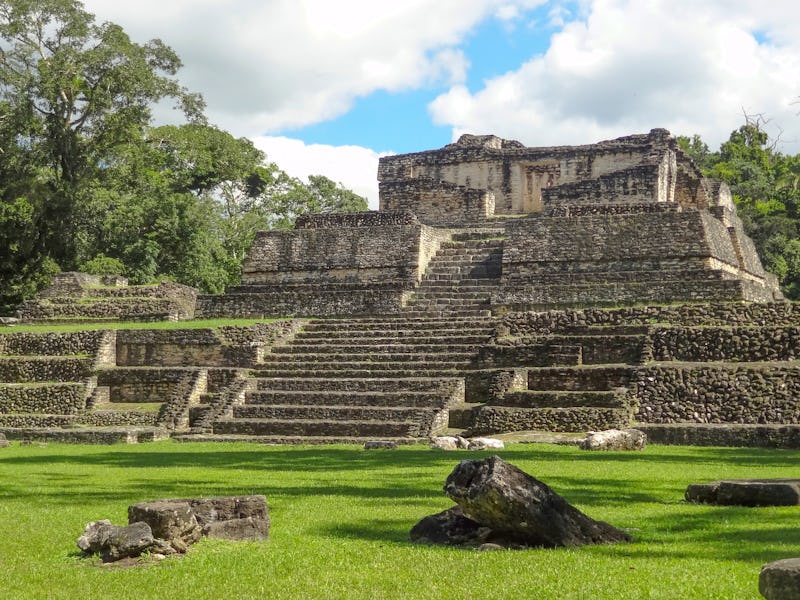Unique Maya farming shows why human adaptability is key to our survival
“We know that a lot of innovation is coming out during that time period."

Over a thousand years ago, the Maya civilization was dealing with an unpredictable climate. In response to natural obstacles including overpopulation and drought, the Maya developed intricate farming techniques, like irrigation canals and wetland farming — cultivating swampy land — to continue feeding its people despite ecological pressures that could have spelled doom.
In fact, wetland systems used for farming and other food sources were much more extensive than previously believed, researchers show in a study published Monday in the journal Proceedings of the National Academy of Sciences. That time period corresponds with extreme drought, as well as both population growth and decline — “demographic dynamism,” as researchers describe it. Today, as humans face sea level rise, increasing natural disasters, and other events brought on by climate change, we can look to the past for some reassurance.
The study analyzes information from an earlier survey done with Light Detection and Ranging (LiDAR), in which scientists sent laser pulses from an airplane toward the ground, through the tree canopy, to measure and identify land features like the vast system of canals.
The researchers looked at four main zones in the Rio Bravo watershed in Belize. They found that one wetland complex of canals and terraces, called Birds of Paradise, is five times larger than expected. They also discovered an even larger complex that was completely unknown until now.
“It turned out that these canals went on for many, many, many times longer than we’d previously thought,” Timothy Beach, Ph.D., professor of soils and geoarchaeology at The University of Texas at Austin and lead author of the study, tells Inverse.
Beach recalls that when he reviewed the results with LiDAR engineer Juan Fernandez, Ph.D., “he said he’d never seen anything like this before.”
The Birds of Paradise ancient Maya wetland field system and parts of the nearby Maya sites of Gran Cacao (bottom-left) and Akab Muclil (top-left) in northwestern Belize.
Maya people grew crops like maize, beans, squash, and avocado in those complexes. But the water in the Maya canals wasn’t just for irrigation: They were also harvesting clams, snails, mussels, turtles, and fish. Archaeologists like Beach have found mollusk shells that appear to have been cooked.
When Beach works in ancient Maya canals in places like Belize, he sees some of the same patterns that people did thousands of years ago, like wet and dry seasons. As the wet season approaches and canals begin to fill up, it’s clear why the water was important beyond watering crops.
“The first thing you notice is the water is filled with things, it’s filled with life,” Beach says.
So researchers knew that these wetland systems were crucial to ancient civilizations like the Maya, for reasons beyond just farming. And a few years ago, Beach and his colleagues guessed that the systems might be much more extensive than they’d been able to observe. As the new study shows, they were right.
LiDAR revealed intricate networks of canals and terraces for farming crops and harvesting aquatic animals.
“This kind of work shows people that indigenous people around the world have made some remarkable, innovative breakthroughs that have allowed them to be sustainable for a long period of time,” Beach says.
Beach and his colleagues also were able to determine when the Maya people used the wetland systems: Most of them date back to between 1,000 and 1,400 years ago, though some go back as far as 1,800 years.
“They seem to really explode around the Terminal Classic,” Beach says, referring to the period of Mayan history from 800 to 900 A.D.
For now, scientists can only hypothesize about precisely why Maya people built the extensive wetland farming systems. But the evidence suggests adaptation was a key factor.
“We know that a lot of innovation is coming out during that time period,” Beach says. Whether the farming practices were spurred by water level rise or drought, for example, “all of those imply adaptation.”
“We know the Maya faced those,” he adds. “We know the Maya also lived through it.”
With only lithic technology — rocks — the Maya were able to survive throughnumerous environmental changes for thousands of years.
“I think that should give us some optimism,” Beach says. “I’m not optimistic about the climate change part of that, but I’m optimistic about how humans can adapt to things.”
Abstract: We report on a large area of ancient Maya wetland field systems in Belize, Central America, based on airborne lidar survey coupled with multiple proxies and radiocarbon dates that reveal ancient field uses and chronology. The lidar survey indicated four main areas of wetland complexes, including the Birds of Paradise wetland field complex that is five times larger than earlier remote and ground survey had indicated, and revealed a previously unknown wetland field complex that is even larger. The field systems date mainly to the Maya Late and Terminal Classic (∼1,400–1,000 y ago), but with evidence from as early as the Late Preclassic (∼1,800 y ago) and as late as the Early Postclassic (∼900 y ago). Previous study showed that these were polycultural systems that grew typical ancient Maya crops including maize, arrowroot, squash, avocado, and other fruits and harvested fauna. The wetland fields were active at a time of population expansion, landscape alteration, and droughts and could have been adaptations to all of these major shifts in Maya civilization. These wetland-farming systems add to the evidence for early and extensive human impacts on the global tropics. Broader evidence suggests a wide distribution of wetland agroecosystems across the Maya Lowlands and Americas, and we hypothesize the increase of atmospheric carbon dioxide and methane from burning, preparing, and maintaining these field systems contributed to the Early Anthropocene.